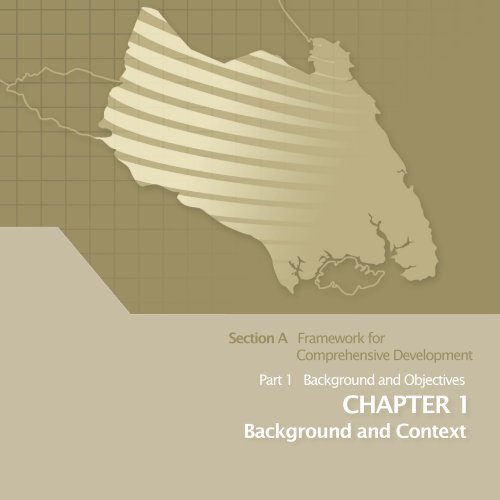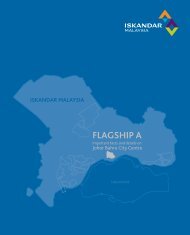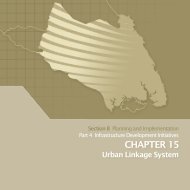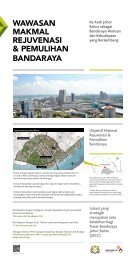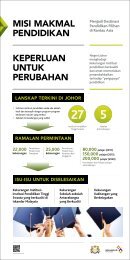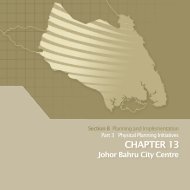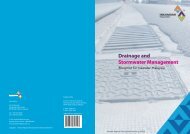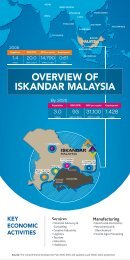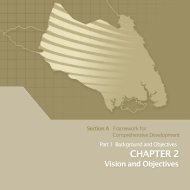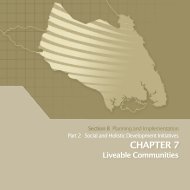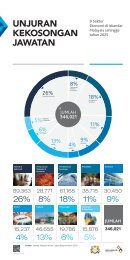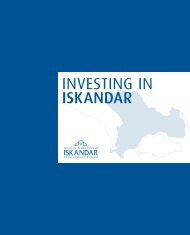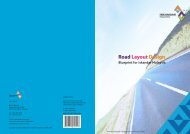CHAPTER 1 - Iskandar Malaysia
CHAPTER 1 - Iskandar Malaysia
CHAPTER 1 - Iskandar Malaysia
You also want an ePaper? Increase the reach of your titles
YUMPU automatically turns print PDFs into web optimized ePapers that Google loves.
Section A Framework for<br />
Comprehensive Development<br />
Part 1 Background and Objectives<br />
<strong>CHAPTER</strong> 1<br />
Background and Context
Background and Context<br />
chapter<br />
1<br />
1.1 Introduction<br />
Located at the southern-most tip of Peninsular <strong>Malaysia</strong> and mainland<br />
Asia, South Johor has long played an important and strategic role in<br />
the history and development of <strong>Malaysia</strong> and its surrounding region.<br />
Johor Bahru, the capital city of Johor and its surrounding areas, has<br />
grown to become the second most important economic conurbation<br />
in <strong>Malaysia</strong>. The economy is well diversified with successful clusters<br />
emerging around the electronics, logistics, food and agriculture,<br />
tourism and oil and petrochemical industries. Its strategic geographic<br />
position on the world’s busiest shipping routes, its proximity to an<br />
international hub and the large markets of Singapore, Indonesia and<br />
further out, China and India, and its rich endowment of natural and<br />
human resources has both underpinned Johor’s past successes and<br />
underscores Johor’s future potential.<br />
Johor’s relative prosperity has been anchored by a celebrated history<br />
of uninterrupted and mutually reinforcing combination of political<br />
stability and continuity, a progressive and deeply revered Sultanate,<br />
and social and cultural cohesion among its multi-ethnic population<br />
that has been a constant source of strength, innovation and renewal.<br />
Indeed, in the various fields of politics, administration and culture, Johor<br />
has often been at the forefront of national development and the history<br />
of Johor is in many cases synonymous with the history of <strong>Malaysia</strong>.<br />
The formation of UMNO, the contributions of numerous Johoreans as<br />
important national leaders in politics, administration, business, the arts<br />
and academia, the introduction of modern administration and the use<br />
of the Johor dialect of the national language as the official dialect are<br />
among the many historical testaments to Johor’s enduring significance<br />
to nation-building.<br />
In mid 2005, the Federal Government of <strong>Malaysia</strong>, along with the<br />
State Government of Johor, identified the need for a focused and<br />
developmental approach to the economically and geographically<br />
important region of South Johor. In arriving at this approach, the<br />
government had taken into cognisance the dominant trends of our<br />
times including globalisation with its increased competition in the flows<br />
of capital, human resource and ideas, the rise of China and India<br />
and the impact of technology and innovation, among others. While<br />
such trends accorded significant opportunities for economic growth<br />
in South Johor in view of its considerable factor advantages in the<br />
supply of competitively priced land, its strategic geographic position, its<br />
industrial base and connectivity and its cost structure, the same trends,<br />
if unchecked and unmanaged, also represented significant threats to<br />
the enduring prosperity and social cohesion of Johor. In particular, the<br />
government was conscious of the need to equally manage not just the<br />
risks of opportunity loss of not achieving full growth potential but just as<br />
importantly to ensure that such targeted growth comes with equitable<br />
distribution. Indeed, it is this underlying socio-economic philosophy and<br />
practice of growth with equity that has been the bedrock that has<br />
allowed social cohesion, peace and prosperity to take place, by the<br />
grace of God.<br />
1.2 Development of the SJER Master Plan<br />
It is against this backdrop that in July 2005, the Government of<br />
<strong>Malaysia</strong> had tasked Khazanah to conduct a feasibility study for the<br />
development of a special economic zone in South Johor in what was<br />
then referred to as the Southern Belt Economic Zone (SBEZ). A Special<br />
Projects Team (SPT) was formed in Khazanah to undertake the task,<br />
consisting of Khazanah officers, consultants and subject matter experts<br />
from various relevant fields including in town planning, real estate,<br />
1- 1
SECTION A<br />
FRAMEWORK FOR COMPREHENSIVE DEVELOPMENT<br />
economic and financial planning, environmental planning, legal<br />
and regulatory, marketing, business process re-engineering, social<br />
policy, strategy, and in local government. Officers from the Federal<br />
Government and the State Government of Johor were also seconded<br />
to the SPT.<br />
In October 2005, Khazanah presented a Conceptual Outline Plan for<br />
the proposed South Johor Economic Region (SJER) to the National<br />
SJER Planning Committee (NSPC) that concluded that there was<br />
a strong economic, social and developmental rationale for the<br />
proposed development of SJER. The NSPC was chaired together by<br />
the YAB Prime Minister and YAB Chief Minister of Johor. Khazanah<br />
acts as the secretariat for the committee. The NSPC further tasked<br />
Khazanah to develop a detailed and comprehensive Master Plan<br />
for the development of SJER that aimed to address socio-economic<br />
development in a holistic and sustainable fashion. To drive the planning<br />
process, the strategic framework of the proposed SJER was also<br />
adopted by the NSPC in October 2005 and consists of the following;<br />
1. Vision: Development of a Strong, Sustainable Conurbation of<br />
International Standing<br />
2. Foundations to be based on<br />
a. Nation Building<br />
b. Growth and Value Creation<br />
c. Equitable and Fair Distribution among Stakeholders<br />
In March 2006, the Ninth <strong>Malaysia</strong> Plan covering the period 2006 to 2010<br />
was launched by the YAB Prime Minister and inter alia, identified SJER as<br />
one of the catalyst and high-impact developments under the Plan. This<br />
was further reinforced when in July 2006, the YAB Prime Minister, the YAB<br />
Chief Minister of Johor and Khazanah announced further details on SJER<br />
that inter alia stated the following;<br />
■ That the proposed SJER would cover the logistic triangle of<br />
Senai Airport to the north, Port of Tanjung Pelepas (South West)<br />
and Johor Port in Pasir Gudang (South East), encompassing an<br />
area of 2,217 sq km. Several key factors in selecting the area of<br />
SJER was highlighted including, its strong connectivity through<br />
the North-South Expressway, road and rail links to Singapore, air<br />
links and sea links to Indonesia and the region and its strategic<br />
location and proximity to some of the world’s most rapidly<br />
growing economies with some 800 million population within a six<br />
hour flight time radius.<br />
■ That the SJER Master Plan would, inter alia, look to address<br />
several key risks that has hampered regional development in the<br />
past, including uncoordinated and duplicative development,<br />
excessive private value capture and potential marginalisation of<br />
the local population. It was also emphasized that a cornerstone<br />
of the proposed Master Plan is the need to ensure that the<br />
rights of the Federal and State Governments under the Federal<br />
Constitution are preserved, specifically Johor’s constitutional<br />
rights on land matters.<br />
3. Five main strategic pillars<br />
a. International Rim Positioning<br />
b. Establishing hard and soft infrastructure enablers<br />
c. Investments in catalyst projects<br />
d. Establishing a strong institutional framework and the<br />
creation of a strong regulatory authority<br />
e. Ensuring socio-economic equity and buy-in from the<br />
local population<br />
■<br />
■<br />
Further, it was highlighted that a key feature of the proposed<br />
Master Plan will be the emphasis on sustainable development,<br />
conservation of the environment and equitable distribution of<br />
the benefits of growth among the local population<br />
It was also highlighted that a key component of the SJER is the<br />
creation of a “one-stop fast track mechanism agency” where<br />
Federal and State Government agencies will work seamlessly to<br />
provide a facilitative environment for investors and consumers.<br />
The Federal and State Governments will play a major role in<br />
facilitating the creation of an investor-friendly environment<br />
through immigration, education, tax, land and close liaison with<br />
local authorities.<br />
1 - 2
BACKGROUND AND CONTEXT <strong>CHAPTER</strong> 1 | PART 1<br />
■ In addition to its planning role, it was identified that Khazanah<br />
would also play a catalytic investment role, investing directly or<br />
indirectly, wholly or in partnership into catalyst infrastructure and<br />
development projects. Among others, several catalyst projects<br />
were highlighted, at various stages of study and implementation<br />
including the Johor State New Administrative Center (JSNAC),<br />
Southern Johor Industrial Logistic Cluster, Waterfront City,<br />
Medical Hub, Edu-city, and a proposed international destination<br />
resort. These initiatives were identified to complement the many<br />
important ongoing developments in various sectors by the major<br />
economic players already well established in SJER, including,<br />
the Port of Tanjong Pelepas (PTP), the UEM Group, Senai Airport,<br />
Danga Bay and Johor Corporation, among others.<br />
The announcement in July 2006 also highlighted that the SJER Master<br />
Plan was targeted to be completed before the end of 2006, and, at<br />
that point, was envisaged to consist of several sub-plans, structured<br />
to cover the Physical Plan, the Economic Plan, the Commercialisation<br />
Plan, the Regulatory Plan and the Social Plan. This document, dated<br />
November 4th 2006 is the culmination of the work over the past fifteen<br />
months and represents Khazanah’s proposal for a Comprehensive<br />
Development Plan (CDP) for the SJER development. As highlighted<br />
in the acknowledgements pages, this document, while representing<br />
the views and recommendations of Khazanah, is indeed the sum<br />
total of the numerous and great contributions from many parties and<br />
individuals, without which this exercise would not have been possible. In<br />
particular, the inputs, views and contributions of the State and Federal<br />
Governments in this regard were especially critical and invaluable.<br />
It also follows that being a document that represents the views and<br />
recommendations of Khazanah, the CDP would be required to be<br />
formally approved and adopted by both the relevant Federal and<br />
State agencies in due course.<br />
The report is divided into seventeen chapters, in two main sections.<br />
Section A: Framework for Comprehensive Development consists of<br />
five chapters. The first two chapters in Part 1 of the section covers<br />
the background and context (Chapter 1) and vision and objectives<br />
(Chapter 2) of the SJER development. The next three chapters in Part<br />
2 outline development strategies from the standpoint of physical<br />
development (Chapter 3), economic development (Chapter 4) and<br />
social development (Chapter 5). The overarching theme of this section<br />
is to link the interconnectedness of the three main development<br />
approaches – physical, economic and social – into the holistic and<br />
comprehensive development framework that the plan aspires to.<br />
Section B: Planning and Implementation consists of twelve chapters<br />
divided into five parts. The section builds on the development context,<br />
framework and strategies discussed in Section A and focuses on the<br />
“how to” to realise the strategies outlined in the previous section. In<br />
particular, specific planning and development initiatives are tabled<br />
with an emphasis on specific actionable items. Each of the five parts<br />
represents the multi-prong and holistic approach to SJER development,<br />
covering the regulatory, legal and institutional framework and initiatives<br />
(Part 1, Chapter 6), the social and holistic development initiatives (Part<br />
2, Chapters 7 and 8), physical planning initiatives (Part 3, Chapters 9 to<br />
13), infrastructure development initiatives (Part 4, Chapters 14 to 16) and<br />
commercial development initiatives (Part 5, Chapter 17).<br />
1.4 South Johor in the Regional and Global Context<br />
As discussed, with increased globalisation and liberalisation, and the<br />
resulting increased pace in the movement of capital, skilled labour<br />
and information flows, it is especially important that the development<br />
plans of SJER takes into account these regional and global trends and<br />
perspectives.<br />
1.3 Structure and outline of the CDP<br />
The structure, outline and content of the CDP is driven by the mandated<br />
task of coming up with a “detailed and comprehensive Master Plan<br />
for the development of SJER that aims to address socio-economic<br />
development in a holistic and sustainable fashion”.<br />
A. Regional ASEAN and Asia-Pacific Perspective<br />
ASEAN already exerts a significant influence on <strong>Malaysia</strong>’s economy,<br />
accounting for 23% of <strong>Malaysia</strong>’s exports in 2001. Singapore is <strong>Malaysia</strong>’s<br />
largest trade partner after USA and nearly half of the trade between<br />
<strong>Malaysia</strong> and Singapore goes through Johor. In addition to being<br />
a major export market, China has also emerged as the principal<br />
1 - 3
SECTION A<br />
FRAMEWORK FOR COMPREHENSIVE DEVELOPMENT<br />
competitor for ASEAN, in terms of exports as well as a destination<br />
for investments in view of its cheap labour and cost of production.<br />
This has further accelerated since China’s entry into the World Trade<br />
Organisation (WTO) in 2001. Indeed, there has been notable evidence<br />
of some international electronic, textile and garment manufacturers<br />
that have recently relocated from Johor to China to take advantage of<br />
lower costs and the large domestic market.<br />
Figure 1.1 : The National Physical Plan, 2005-2020<br />
Spatial Development Strategy<br />
B. Indonesia-<strong>Malaysia</strong>-Singapore Growth Triangle (IMS-GT)<br />
The IMS-GT currently includes Singapore, Johor and province of Riau<br />
(in particular, Batam) in Indonesia and will later be expanded to<br />
include Negeri Sembilan, Malacca and Pahang in <strong>Malaysia</strong>, and<br />
West Sumatera, South Sumatera, Bengkulu, Jambi, Lampung and<br />
West Kalimantan in Indonesia. IMS-GT aims to drive economic growth<br />
within the region through improving competitiveness and enhancing<br />
integration. The private sector is expected to act as a driving force for<br />
this, with the government as facilitator.<br />
Johor draws natural advantages from proximity to Singapore.<br />
Singapore, with its population base of 4.2 million, has traditionally<br />
played the role of ASEAN’s trading, services and especially logistics<br />
hub. Spillover from the vibrant Singaporean economy has been<br />
significant; as an indication, the island of Batam in Indonesia has been<br />
a key beneficiary of its proximity to Singapore, and has emerged as<br />
a fast growing offshore manufacturing centre in South East Asia. With<br />
two direct road links to Singapore and sea links to Batam, SJER is well<br />
positioned to benefit from this broader growth area.<br />
Source : NPP 2005-2020, Federal Town and Country Planning Department,<br />
<strong>Malaysia</strong><br />
1.5 SJER and the National Physical Plan (NPP) 2005-2020<br />
The National Physical Plan (NPP) is a long term national level plan for<br />
the period until 2020 that spells out strategic policies that will determine<br />
directions and trends of the physical development and conservation of<br />
areas within Peninsular <strong>Malaysia</strong>. Approved by the cabinet on the 20th<br />
April 2005 and by the National Physical Planning Council (NPPC) on the<br />
26th April 2005, NPP has been prepared under the provision of Section<br />
6B of the Town and Country Planning Act 1976 (Act 172). The main goal<br />
of the NPP is to create an efficient, equitable and sustainable national<br />
spatial framework to guide the overall development of the country<br />
towards achieving a competitive developed nation status by 2020.<br />
1 - 4
BACKGROUND AND CONTEXT <strong>CHAPTER</strong> 1 | PART 1<br />
In line with this goal, the NPP’s main objectives are as follows:<br />
■ To rationalise national spatial planning for economic efficiency<br />
and global competitiveness;<br />
■ To optimise utilisation of land and natural resources for<br />
sustainable development;<br />
■ To promote balanced regional development for national unity;<br />
and<br />
The SJER is the Johor Bahru Conurbation as identified by the NPP. As<br />
a regional growth conurbation, SJER aims to balance out national<br />
growth such that the southern part of Peninsular <strong>Malaysia</strong> will be a<br />
key beneficiary, whilst playing a symbiotic support role to the Level 1<br />
– National Growth Conurbation of Kuala Lumpur. To further support<br />
the NPP, an integrated National Transportation Network for Peninsular<br />
<strong>Malaysia</strong> has been proposed that comprises three main aspects:<br />
■<br />
To secure spatial and environmental quality and diversity for a<br />
■<br />
Network Configuration<br />
high quality of life<br />
■<br />
National Gateways and Transportation Nodes<br />
Table 1.1 : National Physical Plan Hierarchy of Conurbations, 2020<br />
■<br />
Urban Transportation and Intelligent Transport System<br />
Level Description Area<br />
1 National Growth Cornubation Kuala Lumpur-<br />
Klang Valley-Seremban<br />
2 Regional Growth Conurbations<br />
National Growth Conurbation<br />
George Town- Kulim-<br />
Sungai Petani-<br />
Northern Perak<br />
Johor Bahru-Pasir Gudang-<br />
Tanjung Pelepas<br />
Kuantan-Kemaman<br />
Under the NPP, a high-speed rail system has been identified, and it<br />
is proposed to link the Kuala Lumpur Conurbation to the SJER. It is<br />
envisioned that this rail system could subsequently be linked to Penang<br />
and Kuantan.<br />
Airports and sea ports are expected to play a major role in supporting<br />
the NPP. In this instance Senai Airport (Sultan Ismail International Airport),<br />
is to be integrated with the Port of Tanjung Pelepas as one of the cargo<br />
transhipment mega hubs for the region.<br />
3 Intermediate Growth<br />
Conurbation<br />
4 Urban Growth Centre/Future<br />
Conurbation<br />
Ipoh<br />
Melaka<br />
Alor Setar<br />
Kota Bharu<br />
Kuala Terengganu<br />
Kangar<br />
Termerloh-Mentakab<br />
Lumut-Sitiawan-Manjung<br />
Muar-Batu Pahat-Kluang<br />
NPP 11 – The Conurbation shall be planned and developed as integrated<br />
regions<br />
The NPP also calls for the conurbations to be planned as integrated<br />
regions. In this regard, the CDP, spanning an area across five local<br />
planning authorities, is in effect an integrated approach consistent with<br />
the principles of NPP 11.<br />
Source: National Physical Plan, (NPP) 2005-2020.<br />
In respect of SJER, the NPP has identified the Johor Bahru Conurbation<br />
as the principal conurbation for Southern Peninsular <strong>Malaysia</strong> and<br />
as one of the second tier conurbations (along with the Penang and<br />
Kuantan Conurbations) after the Kuala Lumpur Conurbation in the<br />
overall hierarchy of urban centres. These conurbations are to be the<br />
prime centres for international and local investments.<br />
In addition, the CDP also addresses issues pertaining to transportation,<br />
water supply, sewerage system, solid waste disposal, green belts,<br />
industrial estates and major employment centres. All these are among<br />
the underlying factors required of regional plans as mentioned in the<br />
NPP.<br />
1 - 5
SECTION A<br />
FRAMEWORK FOR COMPREHENSIVE DEVELOPMENT<br />
1.6 SJER and the Ninth <strong>Malaysia</strong> Plan, 2006-2010<br />
The Ninth <strong>Malaysia</strong> Plan (2006-2010) reemphasises the call for balanced<br />
regional development, with development being driven by the growth<br />
centres of respective states as well as trans-border areas. In particular,<br />
the Ninth <strong>Malaysia</strong> Plan has identified SJER as the focus area for<br />
development in the southern region of Peninsular <strong>Malaysia</strong> and as one<br />
of the major catalyst and high-impact developments under the plan.<br />
In preparing the CDP, particular emphasis was placed to ensure that<br />
the strategies and initiatives are in accordance to the five thrusts of the<br />
Ninth <strong>Malaysia</strong> Plan, which are highlighted in Table 1.2<br />
Table 1.2 : Five Thrusts of the Ninth <strong>Malaysia</strong> Plan<br />
Thrust Key Thrusts Statements<br />
Thrust 1 To Move The Economy Up The Value Chain<br />
■ Spur and generate the economic growth in a continuous,<br />
comprehensive and balanced manner;<br />
■ Manage development and the environment intelligently; and<br />
■ Enhance the living quality of life of every citizen.<br />
In addition, the CDP has been prepared by taking in as inputs the<br />
development strategies outlined in the Draft Johor State Structure Plan<br />
that include, inter alia:<br />
■ To diversify economic development by using existing and<br />
natural economic resources in a sustainable manner and by<br />
introducing new, innovative and productive foundations.<br />
■ To strengthen Johor Bahru’s role as the Southern Growth Centre<br />
by forming the Johor Bahru Conurbation that will extend her<br />
boundary from Pasir Gudang to Pekan Nanas.<br />
Thrust 2<br />
To Raise The Capacity For Knowledge And Innovation And<br />
Nurture “First Class Mentality”<br />
■<br />
To enhance efforts to transform the state into an international<br />
transportation and distribution hub.<br />
Thrust 3<br />
To address persistent socio-economic inequalities<br />
constructively and productively<br />
■<br />
To spur the development of towns and growth centres in the<br />
state is to be in line with the ‘Centralised and Decentralised<br />
Thrust 4<br />
Thrust 5<br />
To improve the standard and sustainability of quality of life<br />
To Strengthen The Institutional And Implementation<br />
Capacity<br />
■<br />
Growth Strategy’.<br />
To ensure that all development in the state is sustainably<br />
implemented with an emphasis on safeguarding the<br />
environment.<br />
Source: Ninth <strong>Malaysia</strong> Plan<br />
1.7 SJER and the Draft Johor State Structure Plan 2006-2020<br />
The Draft Johor State Structure Plan has outlined a development vision<br />
for Johor by the year 2020 to be:<br />
“A Developed, Sustainable and Glorious Johor”<br />
(Johor Maju, Lestari dan Gemilang)<br />
The CDP has also been prepared to take cognisance of this plan and<br />
the aspirations and the policies and framework therein. In particular,<br />
guidance is taken from the three key fundamental guiding principles:<br />
■<br />
■<br />
■<br />
■<br />
To establish an efficient and comprehensive communication<br />
network for the whole of Johor with several transportation<br />
modes including road, air, rail and water.<br />
To enhance the integration of public transportation in urban and<br />
rural areas, to be supported by an efficient traffic management<br />
system.<br />
To encourage harmony and integration within the community,<br />
as well as improve quality of life by providing basic utilities and<br />
social and communal amenities.<br />
To continue efforts in creating a transparent and efficient state<br />
administration system.<br />
1 - 6
BACKGROUND AND CONTEXT <strong>CHAPTER</strong> 1 | PART 1<br />
The Draft Johor State Structure Plan has identified four main planning<br />
zones and these are as follows:<br />
Table 1.3 : Development Focus in Johor Planning Zones<br />
Planning Zones<br />
Southern Planning Zone (Johor<br />
Bahru Conurbation)<br />
Western Planning Zone<br />
Eastern Planning Zone<br />
Central Planning Zone<br />
Central Planning Zone<br />
International Trade, Business and<br />
Service Centre<br />
Main City Centre supported by<br />
manufacturing industry, business and<br />
modern agriculture<br />
Tourism Centres at Beaches, Islands<br />
and Natural Environment Areas<br />
Forest Reserve Conservation Zone,<br />
Water Catchments Area and Palm<br />
Oil Estates<br />
Source : Draft Johor State Structure Plan, 2006-2020<br />
In preparing the CDP, it was identified that by and large the CDP is<br />
consistent with the Draft Johor State Structure Plan. The key difference<br />
being on the emphasis of scope, whereby the SJER Plan focuses on the<br />
Southern Planning Zone of the Draft Johor State Structure Plan.<br />
1 - 7


